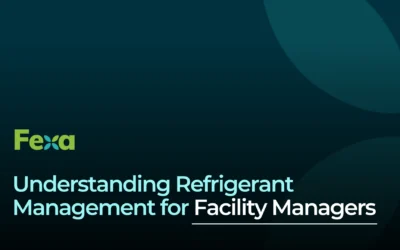SERVICE PROVIDER & VENDOR MANAGEMENT
Guide to Service Provider and Vendor Management
Here’s your ultimate guide to service provider and vendor management.
Effective service provider and vendor management in operational environments is vital to maintaining cost control, operational efficiency, and consistent service quality. Whether managing facilities maintenance, coordinating multi-site operations, or overseeing critical vendor relationships, a structured approach can help organizations achieve long-term success.
In this guide, you’ll find key principles, pressing challenges, and recommended tools for effective vendor and service provider management.
What is Service Provider Management in Facility Management?
Service provider and vendor management is all about keeping things running smoothly by working with external contractors and vendors for essential services like maintenance, repairs, and specialized tasks. It’s about finding the right people, keeping an eye on how they’re doing, and making sure their work lines up with your goals. Done right, it protects your facilities from risks like poor workmanship, compliance issues, or unexpected disruptions. Plus, it helps build strong, collaborative partnerships that create value over the long haul.
Why is Effective Vendor Management Critical for Multi-Site Operations?
For organizations with geographically dispersed operations, vendor management becomes exponentially more challenging and critical. Poor management across multiple sites can result in service inconsistencies, cost overruns, and operational inefficiencies. Effective vendor management ensures that:
- Service Quality Remains Consistent: Vendors are held to uniform standards across locations.
- Costs are Controlled: Efficient vendor selection and performance tracking reduce unnecessary expenses.
- Operational Downtime is Minimized: Quick response times and streamlined communication ensure smooth operations.
By implementing a centralized strategy and leveraging technology, organizations can overcome these challenges and maintain seamless operations across all locations. Let’s dive in to how to make that happen.
Challenges of Managing Vendors Across Multiple Locations
Managing vendors across multiple sites presents unique complexities that can quickly overwhelm even the most experienced facilities managers. Here are some of the most pressing challenges:
- Communication Overload: Facilities managers often coordinate with numerous providers, each with their own points of contact and unique processes. This creates a flood of emails, calls, and text messages that can result in critical details being missed. Without centralized communication tools, managing these channels becomes a logistical nightmare, leading to inefficiencies and errors..
- Inconsistent Performance: Different vendors may operate under varying standards, which can result in uneven service quality. This inconsistency is particularly problematic in multi-site operations, where maintaining a uniform standard across all locations is critical. For example, while one vendor may excel in meeting service level agreements (SLAs), another might struggle to adhere to response time expectations or compliance requirements
- Complex Coordination: Emergency situations or large-scale projects often require coordination among multiple trades—from electricians and plumbers to cleanup crews. Without a robust system to manage this complexity, errors and delays are inevitable. For instance, a disaster scenario like a hurricane-induced flood may require simultaneous efforts from multiple providers. Relying on ad hoc communication methods, such as spreadsheets or manual tracking, can amplify the risk of oversight and inefficiency.
- Compliance Risks: Non-compliant providers can expose organizations to significant liabilities, including safety hazards and legal repercussions. Tracking certifications, insurance, and background checks across multiple vendors becomes increasingly challenging as the number of providers grows. Failure to address compliance proactively can lead to delays and even financial penalties.
- Resource Allocation: Managing resources across geographically dispersed sites requires precise planning. Assigning the right provider to the right location at the right time—especially during peak demand or emergencies—is a complex task that can strain internal teams without the support of advanced tools.
For a more detailed guide on handling these challenges effectively, visit What You Need to Know About Managing Multiple Providers.
Key Steps to Successful Vendor Selection
Your first step in effectively managing providers and vendors is choosing the right ones in the first place. By adopting a systematic approach, organizations can mitigate risks and lay the groundwork for successful partnerships. Key steps include:
- Assessing Qualifications and Credentials: Ensuring that vendors meet all required certifications, licenses, and insurance requirements is critical. This vetting process not only minimizes risks but also ensures that vendors have the technical expertise needed to meet organizational demands. Utilize tools like centralized management platforms to track and store compliance documentation, making it easier to verify providers’ qualifications on an ongoing basis.
- Setting Clear Expectations: Establishing clear and detailed contracts helps define service levels, compliance requirements, and payment terms. Service Level Agreements (SLAs) are particularly important as they outline measurable performance metrics such as response times and completion rates. Additionally, contracts should specify escalation procedures and penalties for non-compliance to protect the organization’s interests.
- Leveraging References and Data: Seeking references from trusted industry peers and reviewing historical performance data are crucial steps. Analyzing metrics such as first-time fix rates, adherence to budgets, and customer feedback can provide valuable insights into a vendor’s reliability and capability. Networking events and industry associations can also serve as excellent resources for finding well-regarded providers.
- Prioritizing Flexibility and Scalability: The ideal vendor should be able to adapt to the evolving needs of the organization. This includes scaling resources during peak times or emergencies and being open to customizing their services to fit unique requirements. Vendors that demonstrate flexibility are better positioned to support long-term success.
- Conducting In-Person or Virtual Interviews: Beyond qualifications and references, interviews offer an opportunity to evaluate a vendor’s communication style, problem-solving approach, and alignment with organizational values. These interactions help build trust and ensure that the provider can deliver on expectations.
By adopting a rigorous and holistic selection process, organizations can build partnerships that align with their operational goals while fostering a foundation of trust and accountability. To minimize risks when onboarding new vendors, explore our tips in Mitigating Risk When Hiring Service Providers and Contractors.
Tracking Vendor Performance
Once providers are onboarded, keeping tabs on their performance is key to ensuring they meet expectations and deliver value. Here are some detailed steps to track vendor performance effectively:
- Performance Metrics: Critical Key Performance Indicators (KPIs) like response times, first-time fix rates, completion rates, and adherence to SLAs provide a measurable view of a vendor’s efficiency and reliability. Regularly tracking these metrics ensures that vendors meet the agreed-upon standards. For instance, monitoring first-time fix rates highlights how often issues are resolved without requiring follow-ups, which can save both time and costs.
- Regular Reviews: Schedule Quarterly Business Reviews (QBRs) to sit down with vendors and discuss their performance. These reviews provide a formal opportunity to analyze data, highlight successes, address areas of improvement, and ensure alignment with future goals. Transparency during QBRs helps maintain a healthy partnership and fosters accountability.
- Feedback Loops and Scorecards: Establish open feedback channels where vendors can receive constructive input and share their perspectives. Tools like Fexa’s Provider Performance Snapshot create comprehensive scorecards that track real-time performance metrics. These insights make it easier to identify trends and course-correct issues before they escalate.
- Root Cause Analysis: When performance issues arise, conduct a root cause analysis to identify the underlying problems. Whether it’s delays, compliance failures, or quality concerns, understanding the cause ensures targeted solutions.
By making performance tracking an ongoing process, organizations can build stronger, more productive vendor relationships while addressing inefficiencies proactively. Wondering if it’s time to replace a vendor? Learn more in our webinar Pivoting Providers: When Is It Time to Switch?
Tools and Technology to Streamline Vendor Management
In the age of digital transformation, technology is revolutionizing how vendor management is handled. Modern platforms like Fexa and FexaLink are designed to address the complexities of managing multiple providers while making the process smoother and more efficient. Key features and benefits include:
- Centralized Communication: Instead of juggling emails, phone calls, and spreadsheets, platforms like Fexa centralize all provider communications in one place. This eliminates the chaos of fragmented information and ensures that everyone—from facility managers to vendors—is on the same page. For example, providers can access job updates, share progress, and upload completion reports directly within the platform.
- Automated Compliance Tracking: One of the biggest risks in vendor management is working with non-compliant providers. Fexa’s automation features track certifications, insurance, and other required documents, sending reminders when renewals are due. This proactive approach prevents delays caused by non-compliance and reduces liability.
- Performance Tracking Dashboards: Real-time dashboards allow facility managers to monitor vendor KPIs, making it easier to evaluate their performance. These dashboards highlight trends, such as consistent delays or quality issues, so organizations can address concerns promptly. Advanced analytics also provide insights that can guide decision-making and budget planning.
- Customizable Workflows: Every organization has unique vendor management needs. Tools like Fexa allow users to tailor workflows to include specific requirements like regional compliance rules, location-specific tasks, or emergency protocols. Customization ensures that the technology adapts to the business, not the other way around..
- Mobile Accessibility: With mobile-friendly platforms, facility managers and vendors can access vital information on the go. This is particularly useful during emergencies when quick access to updates and instructions is critical.
By using these technological tools, organizations can save time, reduce errors, and improve overall efficiency in vendor management, creating a seamless and collaborative process that drives success across the board.
The Role of Communication in Vendor Relationships
Strong communication is the backbone of successful vendor relationships. Transparent, regular communication fosters trust, ensures alignment on expectations, and resolves issues proactively. Using platforms like Fexa to automate and streamline communication workflows reduces delays and ensures all stakeholders are informed in real-time.
Avoiding Common Vendor Management Pitfalls
Avoiding common pitfalls is essential for building a strong and effective vendor management process. Here’s a deeper dive into some of the most frequent challenges and how to address them:
- Unclear Expectations: A lack of clarity in contracts can lead to misunderstandings and missed deliverables. Detailed agreements should clearly outline roles, responsibilities, timelines, and performance standards. Avoid vague language—use specifics to ensure there is no room for interpretation. For instance, SLAs should include measurable KPIs, escalation procedures, and penalties for non-compliance.
- Inconsistent Processes: Variability across sites or providers can result in uneven performance. Standardizing workflows and communication methods ensures that all vendors follow the same playbook. Technology can help here by providing templates for contracts, SLAs, and compliance documentation that can be applied across all locations.
- Lack of Oversight: Without regular performance monitoring, small issues can snowball into major problems. Advanced monitoring tools like Fexa’s Provider Performance Snapshot ensure that facilities managers have a clear picture of each vendor’s performance. Regular reviews, combined with real-time performance tracking, create a proactive approach to identifying and resolving issues early.
- Resistance to Feedback: Some vendors may be resistant to constructive criticism. Creating a culture of collaboration, where feedback is seen as an opportunity for improvement rather than criticism, can foster stronger partnerships. Open communication channels and consistent QBRs can help vendors understand the organization’s goals and align their services accordingly.
Driving Cost Savings and Operational Success Through Vendor Management
Effective vendor management doesn’t just prevent problems; it also creates tangible benefits for the organization. Here’s how optimized vendor relationships can drive cost savings and operational success:
- Reduced Waste: Efficient vendor management eliminates redundancies, such as duplicating services or paying for unnecessary callouts. For example, tracking first-time fix rates helps identify providers who consistently resolve issues on the first visit, saving costs associated with repeat visits.
- Improved Efficiency: Streamlining communication and centralizing workflows reduces delays and ensures tasks are completed on time. Automation tools can handle routine processes, such as assigning jobs or notifying vendors about compliance updates, freeing up staff to focus on strategic activities..
- Enhanced Compliance: Staying on top of certifications, insurance, and legal requirements minimizes risk and ensures that providers meet all regulatory standards. Non-compliance can result in hefty fines or operational shutdowns, making proactive tracking a key cost-saving measure.
- Long-Term ROI: Strong vendor relationships result in better pricing, reliable service, and fewer disruptions over time. Investing in tools like Fexa ensures that vendor management processes are efficient and scalable, leading to sustained operational success. These benefits compound over time, creating significant ROI from streamlined vendor management.
By focusing on these areas, organizations can turn vendor management from a reactive task into a proactive strategy that delivers measurable value across the board.
Building a Path to Sustainable Vendor Management
Service provider and vendor management is a critical component of operational excellence. By implementing structured processes, leveraging technology like Fexa, and fostering transparent communication, organizations can overcome challenges, drive cost savings, and build strong vendor relationships. Choosing the right service model can also greatly enhance your facilities maintenance program. Explore the options in Which Service Model is Best For Your Facilities Maintenance Program?.
As facilities management evolves, the ability to effectively manage service providers will remain a cornerstone of business success. Find out how Fexa’s flexible CMMS can help you with service provider and vendor management in a more streamlined, cost-effective way. Join us for a demo today.
Say goodbye to the never-ending to-do list.
Blog
Related Articles
Stay ahead of the curve with our insightful articles, expert opinions, and innovative trends. We are committed to providing you with valuable information and industry insights to help you optimize and manage your facility more effectively.
Why Relationships Matter in the Facilities Management Industry
ARTICLEWhy Relationships Matter in the Facilities Management IndustryFacilities management is much more than ensuring buildings operate efficiently—it’s about creating systems of trust, collaboration, and reliability between managers, service providers, and teams....
Checklist: Get Ready for January’s AIM Act Roll Out
ARTICLE / CHECKLISTGet Ready for January's AIM Act Roll OutCompanies across the nation are preparing for the upcoming roll out of the EPA’s AIM Act, which represents a major shift in refrigerant management requirements. Although new regulations will not take effect...
Understanding Refrigerant Management for Facility Managers
ARTICLEUnderstanding Refrigerant Management for Facility ManagersAs we move into 2025, facility managers who oversee multiple locations are likely to face increasing pressure to master refrigerant management. At Fexa, we have heard from facilities managers who felt...





